David Salman — July 1, 2014
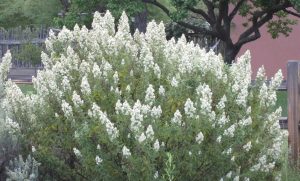
Even the driest garden can come alive with color if the right plants are selected. Here, the Southwest’s premier plantsman recommends some of his favorites for xeric conditions.
Waterwise is another word for “xeric” when referring to plants that grow well with little water. Xeric plants are native to regions where the natural precipitation is low. Being xeric doesn’t mean the same thing as “drought tolerant” (which is a rather meaningless term). A “drought tolerant” plant may survive drought conditions, but it won’t grow and thrive until the precipitation returns to normal levels. Here are just a few of my many favorite xeric plants for regions of the country that receive about 25 inches or less of annual precipitation.
A word about regionality
The plants recommended here are outstanding selections for the xeric conditions of the Intermountain West, including Arizona, Colorado, Idaho, Nevada, New Mexico and Utah. They represent what are called “regionally suitable” plants that are adapted to dry, cold regions, and so they are a good choice for use over a huge area of the western U.S. But they are growable in other parts of the country where drier conditions prevail. By being familiar with your region’s precipitation, climate and growing conditions, you can access a huge diversity of regionally suitable plant material, especially native species, to source plants for your waterwise designs in non-western parts of the country.
Woody Plants
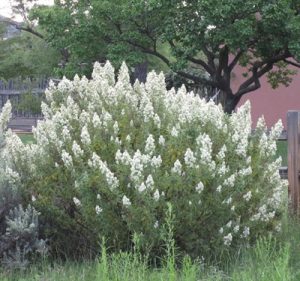
Click image to enlarge.
Fernbush (Chamaebatiaria millefolium) blooms in midsummer with showy white plumes that resemble lilac flowers.
Photos courtesy of David Salman, High Country Gardens
Fernbush (Chamaebatiaria millefolium)
Size: 4 to 6 feet tall by 6 to 8 feet wide
Requirements: Sun; xeric; most soils including dry clay
One of my favorite native shrubs, fernbush blooms in midsummer with showy white plumes that resemble lilac flowers. The semi-evergreen foliage is olive green and attractive. This is an invaluable native plant for feeding native bees in the middle of summer.
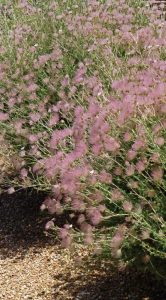
Click image to enlarge.
A member of the rose family, Apache plume (Fallugia paradoxa) is noted for its showy pink seed plumes.
Apache Plume (Fallugia paradoxa)
Size: 4 to 6 feet tall by 6 to 8 feet wide
Requirements: Sun; very xeric; well-drained sandy, rocky or loam soils
A member of the rose family, Apache plume is grown for its showy pink seed plumes that appear on the plant much of the growing season. Once established, this native shrub survives easily on natural precipitation and is susceptible to overwatering, especially when given emitters on a drip system.
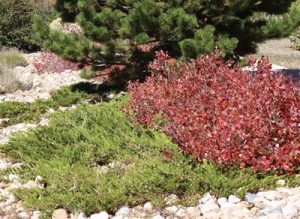
Click image to enlarge.
Displaying brilliant burgundy-red fall foliage, ‘Gro-Low’ sumac (Rhus aromatica) also offers early spring flowers that attract native bees.
‘Gro-Low’ Sumac (Rhus aromatica)
Size: 3 to 5 feet tall by 6 to 8 feet wide
Requirements: Sun; xeric; most soils including clay
Most notable for its brilliant burgundy-red fall foliage, the shrub’s glossy green foliage looks fresh and cool all summer. Plus, its early spring flowers are a valuable source of nectar for native bees. This shrub’s low spreading habit makes it an excellent woody groundcover.
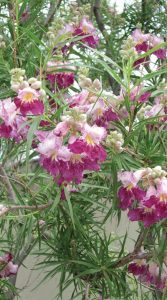
Click image to enlarge.
Desert willow (Chiliopsis linearis) provides ample proof that xeric plants can offer breathtaking color.
Desert Willow (Chilopsis linearis)
Size: 12 to 20 feet tall by 12 to 15 feet wide
Requirements: Sun; xeric; most soils including dry clay
Those in the know have discovered that desert willow is a lot cold hardier than originally rated. Once established, this native large shrub/small tree can take subzero USDA Zone 5 and 6 winter temperatures. And, its heat tolerance makes it a great choice for uber-hot south- and west-facing walls and parking lot medians. The large, showy late-spring/early summer flowers are extremely attractive to hummingbirds. Seek out two seedless, ever-blooming cultivars that will stay in bloom all summer: Timeless Beauty® P.P. and Art’s Seedless™.
Perennial Plants
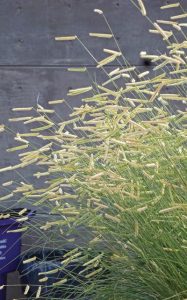
Click image to enlarge.
Blonde Ambition blue grama grass (Bouteloua gracilis) is an exclusive introduction by High Country Gardens.
Blonde Ambition Blue Grama Grass PP#22049 (Bouteloua gracilis)
Size: 30 to 36 inches tall by 30 to 36 inches wide
Requirements: Sun; xeric; most any well-drained soil including dry clay
This fantastic new native ornamental grass is turning heads with its unique display of profuse blonde seed heads. It blooms in mid-summer with horizontal, chartreuse colored flowers, which ripen to blonde in the early fall and hold on the plant through winter. Much larger growing than is typical for this species, ‘Blonde Ambition’ is an excellent companion for other upright growing native grasses like Panicum, Andropogon and Schizachyrium.
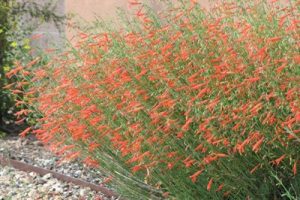
Click image to enlarge.
Beardtongue—the genus Penstemon—offers us some of our showiest native wildflowers that thrive in dry growing conditions.
Beardtongue (Penstemon)
Size: 4 to 36 inches tall by 4 to 18 inches wide
Requirements: Sun; xeric to very xeric; well-drained sandy, rocky or loam soils
The genus Penstemon offers us some of our showiest native wildflowers that thrive in dry growing conditions. They range in size from tiny rock garden species to large, showy species used for roadside revegetation. The key to growing the beardtongues is to leave them alone once established. Too much water, too rich a soil and bark mulch are the kiss of death for these perennials. Many species are somewhat short lived, so I recommend not deadheading and allowing them to reseed themselves.
Penstemon are nature’s bare dirt pioneers, making them a great choice for new gardens. Plus, they’re rabbit and deer resistant.
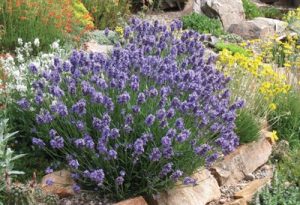
Click image to enlarge.
Lavenders are essential ornamental herbs for the dry landscape. Here, the dwarf form Thumbelina Leigh English lavender (Lavandula angustifolia) tucks neatly into a rock garden.
Lavender (Lavandula)
Size: 15 to 30 inches tall by 3 to 4 feet wide
Requirements: Sun; xeric; well-drained sandy, rocky or loam soils
An essential ornamental herb for dry landscapes, lavender are actually woody subshrubs. I recommend planting both English (L. angustifolia) and French hybrid (L. intermedia) types to extend the blooming from late spring into late summer. There are a handful of reblooming English lavender like ‘Sharon Roberts’, ‘Buena Vista’ and ‘Pastor’s Pride’ that flower in late spring and again in early fall when promptly deadheaded. All are rabbit and deer resistant.
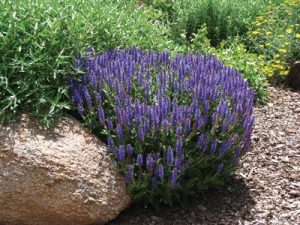
Click image to enlarge.
Tough and colorful, sage (Salvia nemerosa) are among the longest-lived perennials for the xeric landscape. Pictured here is ‘Blue Hill’.
Sage (Salvia superba cultivars)
Size: 12 to 30 inches tall by 15 to 30 inches wide
Requirements: Sun to part sun; xeric; most any soil including clay
This group of Old World sages has proved to comprise some of the toughest, most colorful, longest-lived perennials for xeric landscapes. These long-blooming perennials are also indispensible for providing honeybees with nectar and pollen. My favorites include ‘Marcus’ PP#13322, ‘Blue Hill’ and ‘May Night’ (one of the best perennials ever introduced). All are rabbit and deer resistant.
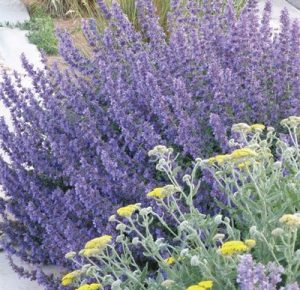
Click image to enlarge.
Pictured here with Moonshine achillea, catmint (Nepeta species) are among the toughest selections for a dry garden. They attract honeybees, and they’re rabbit and deer resistant, too.
Catmint (Nepeta species and cultivars)
Size: 12 to 30 inches tall by 15 to 30 inches wide
Requirements: Sun to part sun; xeric; most any soil including clay
Also of Old World origins, the catmints are a close second to Salvia superba as tough, colorful, long-lived perennials for the xeric landscape. They too are excellent plants for feeding honeybees. Here in my hometown of Santa Fe, where we are in the fourth year of extreme drought, Nepeta has thrived while many other xeric perennials have perished. My favorite cultivars include ‘Walker’s Low’, Nepeta racemosa ‘Grandiflora’ and Nepeta × faassenii ‘Select Blue’. All are rabbit and deer resistant.
Lose the Hedge Trimmers
One of the most beautiful things about many shrubs is their natural shape. Don’t shear shrubs, as this ruins their appearance and turns them into a high- maintenance part of the landscape. It’s unprofessional to specify a plant that is too large for its space and then use shearing to make it fit!
David Salman is founder and chief horticulturist of High Country Gardens catalog operating out of Denver, Colorado. He is a distinguished recipient of the American Horticultural Society 2008 Great American Gardeners Award for Commercial Horticulture, and introduced the award-winning Bouteloua gracilis ‘Blonde Ambition’. He can be reached at [email protected].